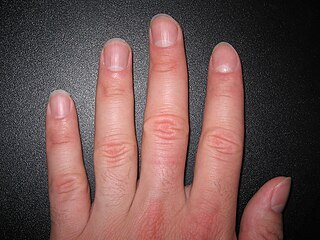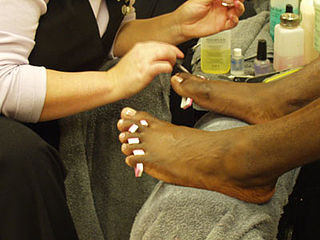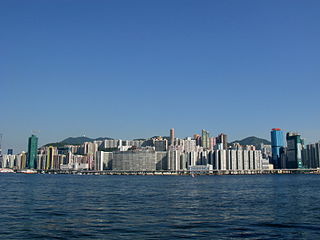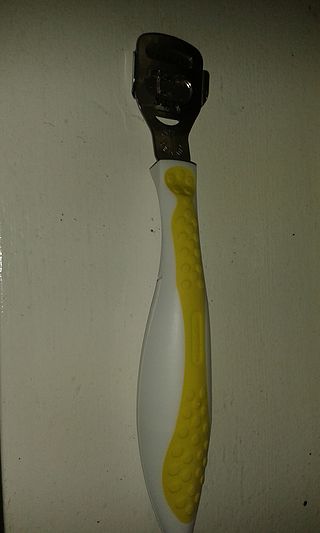Related Research Articles

A manicure is a mostly cosmetic beauty treatment for the fingernails and hands performed at home or in a nail salon. A manicure usually consists of filing and shaping the free edge of nails, pushing and clipping any nonliving tissue at the cuticle and removing hangnails, treatments with various liquids, massage of the hand, and the application of fingernail polish. When the same is applied to the toenails and feet, the treatment is referred to as a pedicure. Together, the treatments may be known as a mani-pedi.

A callus is an area of thickened and sometimes hardened skin that forms as a response to repeated friction, pressure, or other irritation. Since repeated contact is required, calluses are most often found on the feet and hands, but they may occur anywhere on the skin. Some degree of callus, such as on the bottom of the foot, is normal.

A podiatrist is a medical professional devoted to the treatment of disorders of the foot, ankle, and related structures of the leg. The term originated in North America but has now become the accepted term in the English-speaking world for all practitioners of podiatric medicine. The word chiropodist was previously used in the United States, but it is now regarded as antiquated.

A nail is a protective plate characteristically found at the tip of the digits of all primates, corresponding to the claws in other tetrapod animals. Fingernails and toenails are made of a tough rigid protein called alpha-keratin, a polymer also found in the claws, hooves and horns of vertebrates.

A pedicure is a cosmetic treatment of the feet and toenails, analogous to a manicure.

Podiatry, or podiatric medicine and surgery, is a branch of medicine devoted to the study, diagnosis, and treatment of disorders of the foot, ankle and lower limb. The healthcare professional is known as a podiatrist. The US podiatric medical school curriculum includes lower extremity anatomy, general human anatomy, physiology, general medicine, physical assessment, biochemistry, neurobiology, pathophysiology, genetics and embryology, microbiology, histology, pharmacology, women's health, physical rehabilitation, sports medicine, research, ethics and jurisprudence, biomechanics, general principles of orthopedic surgery, plastic surgery, and foot and ankle surgery.

Diseases of the foot generally are not limited, that is they are related to or manifest elsewhere in the body. However, the foot is often the first place some of these diseases or a sign or symptom of others appear. This is because of the foot's distance from the central circulation, the heart and its constant exposure to pressures from the ground and the weight of the body.

An ingrown nail, also known as onychocryptosis is a common form of nail disease. It is an often painful condition in which the nail grows so that it cuts into one or both sides of the paronychium or nail bed. While ingrown nails can occur in the nails of both the hands and the feet, they occur most commonly with the toenails.

Xiaolongbao is a type of Chinese tangbao, traditionally prepared in a xiaolong, a small bamboo steaming basket. The xiaolongbao originates from the city of Changzhou in Jiangsu province, and is an iconic dish of Jiangnan cuisine.

Shanghai Tang is a Hong Kong luxury fashion house founded in 1994 by Hong Kong businessman David Tang. The brand is known for its luxury homeware collection and fine bone china. In 1998, Richemont acquired David Tang's controlling stake in the business.

Chicken feet are cooked and eaten in many countries. After an outer layer of hard skin is removed, most of the edible tissue on the feet consists of skin and tendons, with no muscle. This gives the feet a distinct gelatinous texture different from the rest of the chicken meat.

Shanghainese people in Hong Kong have played an important role in the region, despite being a relatively small portion of the Han Chinese population. "Shanghainese" is a term that refers to both the Wu Chinese language and the Han Chinese subgroups from the city of Shanghai and the peoples of the Jiangnan region in Hong Kong more broadly, particularly those with ancestral homes in parts of southern Jiangsu (Kiangsu), northern Zhejiang (Chekiang) and Anhui provinces.
Duolun Road, formerly Darroch Road, is a historic street in Hongkou District, Shanghai, China.

A corn or clavus is an often painful, cone-shaped, inwardly directed callus of dead skin that forms at a pressure point near a bone, or on a weight-bearing part of the body. When on the feet, corns can be so painful as to interfere with walking. The visible portion of the corn tends to be more-or-less round, but corns are defined by having a hard tapering root that is directed inward, and pressure on the corn pushes this root deeper into the flesh. Pressure corns usually occur on thin or glabrous skin surfaces, especially on the dorsal surface of toes or fingers, but corns triggered by an acute injury may occur on the thicker skin of the palms or bottom of the feet.

Ascot Chang is a brand of bespoke shirts and suits. Ascot Chang opened his first store on Kimberly Road in Hong Kong in 1953. It now has 15 locations across China, Hong Kong, the United States, and the Philippines. High-profile customers include former president George W. Bush, Leonardo DiCaprio, and Andy Warhol.

Shanghai-Style Barber Shop is a barber shop opened by a group of Shanghai barbers coming to Hong Kong mainly in the 1950s to give classical Shanghai haircuts. It is popular in Hong Kong among higher class people in the period of 1950s-1970s, offering a range of classical haircut until today. Other than hair-cutting, Shanghai style barber shops provide different unique services include trimming, massaging, nails clipping, etc. Despite the sunset of Shanghai style barber shop in Hong Kong in the modern days, it still attracts loyal customers, especially among males, and costs around HK$70 for a haircut and shave using traditional clippers.

A callus shaver is a tool for the medical and cosmetic removal of a callus, mainly on the feet, or hands. Technically speaking, its function is the abrasive treatment of hyperkeratotic skin lesions.
The culture of Shanghai or Shanghainese culture is based on the Wuyue culture from the nearby Jiangsu and Zhejiang province, with a unique "East Meets West" Haipai culture generated through the influx of Western influences since the mid-19th century. Mass migration from all across China and the rest of the world has made Shanghai a melting pot of different cultures. It was in Shanghai, for example, that the first motor car was driven and (technically) the first train tracks and modern sewers were laid. It was also the intellectual battleground between socialist writers who concentrated on critical realism, which was pioneered by Lu Xun, Mao Dun, Nien Cheng and the famous French novel by André Malraux, Man's Fate, and the more "bourgeois", more romantic and aesthetically inclined writers, such as Shi Zhecun, Shao Xunmei, Ye Lingfeng and Eileen Chang.

Eight treasure duck, also known as eight treasures duck, is a duck dish in Shanghai and Cantonese cuisine. Its name derives from the fact that it is stuffed with eight other ingredients, including rice, mushrooms and shrimp.
References
- 1 2 3 "Shanghai pedicure, with sharpened blades". In Transit. New York Times. 4 January 2008. Retrieved 6 August 2013.
- 1 2 3 4 5 Olivares-Co, Maja (26 July 2012). "Why I can swear by Shanghainese pedicure". Lifestyle. Inquirer. Retrieved 6 August 2013.
- ↑ Mahon, Kate. "A weekend of pure bliss in Hong Kong". Style. Australian Women's Weekly. Archived from the original on 6 August 2013. Retrieved 6 August 2013.
- ↑ "Enter the scalpel: how Bruce Lee fought with ingrown toenails". South China Morning Post. Retrieved 2018-08-25.